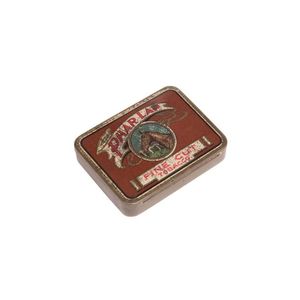Austrian Silver and Moss Agate Cloisonne Box
Austrian silver and plique-a-jour box, c. 1920, of rectangular shape, the lid set with an oval moss agate, with green cloisonne enamel sides, hallmarked, weight 142 grams length 8.5 cm
You must be a subscriber, and be logged in to view price and dealer details.
Subscribe Now to view actual auction price for this item
When you subscribe, you have the option of setting the currency in which to display prices to $Au, $US, $NZ or Stg.
This item has been sold, and the description, image and price are for reference purposes only.
- Agate - Agate is a type of semi-precious gemstone that is made up of silica dioxide, a mineral that is also found in quartz. It is known for its distinctive banded patterns, which are created as layers of silica are deposited in different colours including red, orange, yellow, green, blue, and purple. It is often used in jewellery, decorative objects, and other decorative items, and it is prized for its beauty and durability. Agate is found in many parts of the world, including Brazil, India, and the United States.
- Plique-A-Jour - Plique a jour, which translates from the French as ?glimpse of daylight? is a method of enamelling in which the backing is removed or cut away so the light shines through, with a similar effect to a stained glass window. The enamel is held in place by border.
Although the technique of plique-a-jour has been known and in use since the 6th century, it became popular again in the late 19th century, in Russia and Scandinavia. Plique-a-jour was popular in the Art Nouveau period, especially for jewellery.
Because of the length of time required to produce an item, and the high failure rate, production was limited, and the technique is little used today.
This item has been included into following indexes:
Visually similar items

Phar Lap, nice tin 'Phar Lap, Fine Cut Tobacco', manufactured by Myona Cigar Co. Melbourne
Sold by
in
for
You can display prices in $Au, $US, $NZ or Stg.

Baccarat sulphide paperweight of 'Princess Anne' with original case and stand
Sold by
in
for
You can display prices in $Au, $US, $NZ or Stg.

Sold by
in
for
You can display prices in $Au, $US, $NZ or Stg.

A Regency rosewood and brass inlay writing box c.1820. The box has a two-sided tooled leather writing slope, with interior stationery compartments and lower secret pullout drawer. Length 41 cm. Width 24 cm. Height 14.5 cm
Sold by
in
for
You can display prices in $Au, $US, $NZ or Stg.
